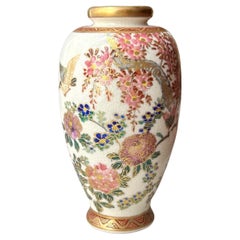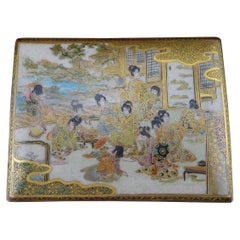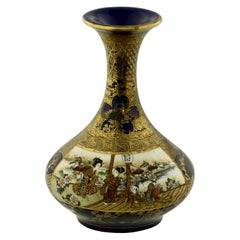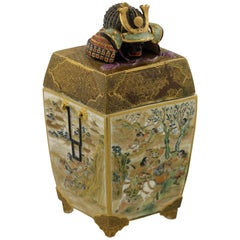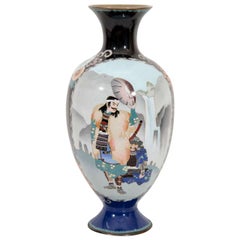Satsuma Asian Art and Furniture
9
to
9
15
5
9
9
9
6
3
2
1
9
3
2
1
5
5
5
9
5
4
3
2
Item Ships From: Florida
Creator: Satsuma
Meiji Period Diminutive Satsuma Baluster Vase.
By Satsuma
Located in Vero Beach, FL
Meiji Period Diminutive Satsuma Baluster Vase.
This Japanese Satsuma vase from the late Meiji period is hand painted and gilt decorated with a Japanese landscape in exquisite detail...
Category
20th Century Japanese Meiji Satsuma Asian Art and Furniture
Materials
Porcelain
19th Century Japanese Satsuma Porcelain Water Well Bucket, Wishing Well Vase
By Satsuma
Located in Vero Beach, FL
This Japanese porcelain vase is barrel shaped with a yolk handle. It is both finely and intricately hand painted. It pictures groups of scholars with scrolls dressed in elaborate brocade kimonos...
Category
Late 19th Century Japanese Meiji Antique Satsuma Asian Art and Furniture
Materials
Porcelain
Japanese Meiji Period Satsuma Large Square Bowl Centerpiece
By Satsuma
Located in Vero Beach, FL
Japanese Meiji Period Satsuma large square bowl
Antique early Meiji Period 15" square with scalloped rim Satsuma bowl. Highly unusual and finely painted. ...
Category
19th Century Japanese Meiji Antique Satsuma Asian Art and Furniture
Materials
Ceramic
Japanese Meiji Satsuma Finely Decorated and Gilded Scenic Box
By Satsuma
Located in Gainesville, FL
Japanese Meiji satsuma finely hand decorated and gilded box. The box depicts a different scene on each side. Marked with a maker's mark on the bottom.
Category
Late 19th Century Japanese Meiji Antique Satsuma Asian Art and Furniture
Materials
Pottery
Satsuma Earthenware Vase, by Kinkozan, Japanese, Meiji Period
By Satsuma
Located in West Palm Beach, FL
A Satsuma Earthenware Vase,
by Kinkozan,
Japanese, Meiji period (1868-1912)
decorated in polychrome enamels and gilt over a clear, crackled glaze, delicately painted with ladies and men, the reverse with a flowering garden with sprays of flowers, the neck with geometric and floral designs, a band of kifu heads in silver and gilt above the foot, on a midnight-blue ground, signed Kinkozan zo...
Category
1860s Antique Satsuma Asian Art and Furniture
Materials
Earthenware
Satsuma Earthenware Vase and Cover, Japanese, Meiji Period
By Satsuma
Located in West Palm Beach, FL
A Satsuma Earthenware vase and cover,
Japanese, Meiji period, (1868-1912)
decorated in polychrome enamels and gilt over a clear, crackled glaze, delicately painted with samurai on ...
Category
1890s Antique Satsuma Asian Art and Furniture
Materials
Ceramic
Satsuma Earthenware Covered Box, by Kinkozan
By Satsuma
Located in West Palm Beach, FL
A Satsuma Earthenware covered box,
by Kinkozan,
Japanese, Meiji period (1868-1912)
decorated in polychrome enamels and gilt over a clear, crackled glaze, delicately painted with s...
Category
Early 1900s Antique Satsuma Asian Art and Furniture
Materials
Earthenware
Satsuma Earthenware Flat Shouldered Ovoid Vase, Garlic Mouth by Yabu Meizan
By Satsuma
Located in West Palm Beach, FL
A Satsuma earthenware flat shouldered ovoid vase with garlic mouth by Yabu Meizan,
Osaka, 1853-1934,
decorated in polychrome enamels and gilt over a cle...
Category
1890s Antique Satsuma Asian Art and Furniture
Materials
Earthenware
Spectacular 3 Piece Japanese Satsuma Peacock Vases and Tea Pot Set
By Satsuma
Located in Miami, FL
Antique, Meji Era, Japanese 3pc. SATSUMA Double Peacock Vase, Single Peacock Vase and Tea Pot with Flowered Lid and Bamboo Handle. There are no chips, cracks, or repairs,
Tall Va...
Category
Early 20th Century Japanese Meiji Satsuma Asian Art and Furniture
Materials
Ceramic
Related Items
Showa Period Tall Deep Green Ground Cloisonne Vase
Located in Lymington, Hampshire
A Showa period tall deep green ground cloisonne vase, with three white and pink orchids, silvered metal mounts, Japanese, mid-20th century.
Category
Mid-20th Century Japanese Showa Satsuma Asian Art and Furniture
Materials
Ceramic
A Japanese Blue Cloisenne Meiji Period Vase with Samurai Figures
Located in New York, NY
A Meiji Period Japanese Cloisenne vase with figures of Samurai on one side, and floral decoration on the other.
Category
19th Century Japanese Antique Satsuma Asian Art and Furniture
Materials
Enamel
Japanese Porcelain Charger finely Hand Painted, Meiji Period circa 1880
Located in Lincoln, Lincolnshire
This is a good quality, hand decorated Japanese porcelain charger, large plate or bowl with an Imari pattern, dating to the late 19th centur...
Category
Late 19th Century Japanese Meiji Antique Satsuma Asian Art and Furniture
Materials
Porcelain
Satsuma Japanese Meiji Miniature Enameled Teapot Kozon Mark
By Satsuma
Located in Bishop's Stortford, Hertfordshire
An exceptional Japanese Satsuma miniature spool shaped pottery teapot and cover finely hand enameled with Kozon mark and dating from around 1880. This delightful teapot has an invers...
Category
19th Century Japanese Meiji Antique Satsuma Asian Art and Furniture
Materials
Pottery
A pair of large Meiji period Satsuma Rouleau vases
Located in London, GB
A pair of large Meiji period Satsuma Rouleau vases
Japanese, Late 19th Century
Height 54.5cm, diameter 24cm
These beautiful Satsuma-ware vases were made ...
Category
Late 19th Century Japanese Meiji Antique Satsuma Asian Art and Furniture
Materials
Earthenware
Large Japanese Ko-Kutani Charger, Early 20th Century
Located in Melbourne, Victoria
A rare yellow ground Japanese ceramic charger 15.5 inches in diameter.
Decorated on a yellow base with a bird, foliage and blossom in shades of yellow, blue, brown and green.
S...
Category
Early 20th Century Japanese Meiji Satsuma Asian Art and Furniture
Materials
Porcelain
Satsuma earthenware vase by kinkozan, Meiji period
By Kinkozan
Located in Tel Aviv - Jaffa, IL
the body of this small marvelous vase is painted with a scene of a puppet show vendor with his wood backpack, on top of the backpack there are toys and dolls, he is surrounded with a group of 6 children, and on the background you can see a village.
on the other side of the vase there is an amazing painting of flowers and on the sides there are two amazing strong pine trees, the amorphous background is decorated in a "Tortoiseshell" color and design that gives it a real character and which is quite rare to see on satsuma pottery.
all the vase is over richly overpainted over the glaze with gold, which gives it its depth and realism.
signed Kyoto Kinkozan zo, and sealed Kinkozan zo
Kyoto’s Satsuma:
The painting technique used in Kyoto’s Satsuma-style ware is said to be the invention of the sixth generation Kinkōzan Sōbei (1824–1884). The Kinkōzan were a famous family of Kyoto Awataguchi potters who made ceramics that were used at Shōren'in, a temple closely tied to the imperial family, and by the shoguns of the Edo government. In fact the shogun is said to have granted them the name Kinkōzan. With the upheavals at the end of the Edo period, however, and the reforms of the subsequent Meiji government, the potters lost their traditional patrons and had to develop new markets.
Just at that time, the visit of a certain Westerner is said to have decided them to embark on overseas trade. By 1870, they had perfected Kyō Satsuma...
Category
1890s Japanese Meiji Antique Satsuma Asian Art and Furniture
Materials
Gold
Antique Japanese Meiji Satsuma Painted Vase
By Satsuma
Located in LA CIOTAT, FR
A petite and beautiful hand-decorated ceramic baluster vase, painted all around with traditional Japanese motifs, including native flora, birds and bamboo stems on a creamy glazed background. The colour palette is bold and bright, with highlights of green, red and blue, together with plentiful gilt relief...
Category
19th Century Japanese Meiji Antique Satsuma Asian Art and Furniture
Materials
Ceramic
Japanese Imari Charger, Meiji Period, Late 19th Century
Located in Austin, TX
A nicely decorated Japanese Meiji Period Imari charger, late 19th century, Japan.
The porcelain charger featuring a design of a hoho bird, or phoenix, per...
Category
Late 19th Century Japanese Meiji Antique Satsuma Asian Art and Furniture
Materials
Enamel
Antique 19th Century Japanese Satsuma Covered Tripod Box Japan Yokohama Satsuma
Located in Amsterdam, Noord Holland
Fabulous Japanese Satsuma ware tripod lidded box.
Marked ??Nippon ??Yokohama ???Yasui-zo(made) which means that it is so called Yokohama-Satsuma
Condition:
Overall condition 1...
Category
19th Century Japanese Meiji Antique Satsuma Asian Art and Furniture
Materials
Earthenware
Magnificent Antique Japanese Satsuma Vase, Meiji Era, Signed
Located in London, GB
A fine antique Japanese Satsuma vase.
Meiji period. Signed.
A very nice 19th century Japanese Satsuma ware vase of a relatively ...
Category
Late 19th Century Japanese Antique Satsuma Asian Art and Furniture
Materials
Ceramic, Porcelain
Small Japanese Satsuma Incense Burner, Koro, Meiji Period, Late 19th Century
Located in Austin, TX
A fine Japanese Satsuma stoneware incense burner, koro, Meiji Period, late 19th century, Japan.
The koro of square shape with curved sides, supported by four shaped and splayed le...
Category
1890s Antique Satsuma Asian Art and Furniture
Materials
Enamel
H 5.25 in W 4 in D 3.75 in
Satsuma asian art and furniture for sale on 1stDibs.
Satsuma asian art and furniture are available for sale on 1stDibs. These distinctive items are frequently made of ceramic and are designed with extraordinary care. There are many options to choose from in our collection of Satsuma asian art and furniture, although brown editions of this piece are particularly popular. If you’re looking for additional options, many customers also consider asian art and furniture by Ando Jubei, Makuzu Kozan, and Kinkozan. Prices for Satsuma asian art and furniture can differ depending upon size, time period and other attributes — on 1stDibs, these items begin at $580 and can go as high as $13,500, while a piece like these, on average, fetch $1,825.
Creators Similar to Satsuma
Questions About Satsuma Asian Art and Furniture
- What is a Japanese Satsuma vase?1 Answer1stDibs ExpertOctober 12, 2021A type of Japanese pottery originated from Satsuma province in Japan is termed as Satsuma ware. A vase of this kind is known as a Satsuma vase. An interesting fact about Satsuma ware is that they feature a "makers mark" or marking as a key to help collectors unlock the value, age and authenticity of the piece. Shop a range of antique and vintage Japanese vases on 1stDibs.
- How do I date a Satsuma vase?1 Answer1stDibs ExpertMarch 22, 2022To date a Satsuma vase, study its mark. Vases made before World War II normally feature a mark in Japanese. A vase that says "Royal Satsuma" likely dates back to the late 20th century. You'll find a variety of expertly vetted Satsuma vases on 1stDibs.
- Is Satsuma pottery valuable?1 Answer1stDibs ExpertApril 26, 2024Yes, some Satsuma pottery is valuable. The age, type, style and condition will determine how much a particular piece is worth. In addition, the history of ownership may also make a piece more valuable. For example, if a piece was previously in the collection of a notable person, such as a member of the Japanese Imperial Family, it may be worth more. To get an estimated value for a particular piece, consult a certified appraiser or knowledgeable antiques dealer. Find a range of Satsuma pottery on 1stDibs.
- 1stDibs ExpertApril 5, 2022Satsuma porcelain or pottery includes a maker’s mark with the name of the person who made the item. Japanese numbers may also indicate that a Satsuma piece was part of a collection. Genuine Satsuma pieces will not have a “Made in Japan” label and should only include Japanese characters. When in doubt, work with a certified appraiser to determine the authenticity of your Satsuma piece. Find a variety of expertly vetted Satsuma porcelain and pottery collectibles on 1stDibs.
- 1stDibs ExpertFebruary 1, 2024One way to tell if your Satsuma vase is valuable is to look for markings on it. The oldest and typically most expensive pieces will usually have the Shimazu family crest — a circle with a cross through it — hand-painted on the bottom. If the piece is stamped with the marking or says "Made in Japan" in the Roman alphabet, it is a newer vase. Factors like the style of the vase and its condition will also impact its price. It's a good idea to have a certified appraiser or knowledgeable dealer evaluate your vase to determine its value. Find a variety of Satsuma vases on 1stDibs.
